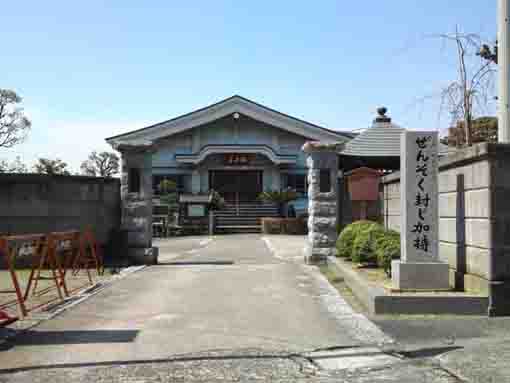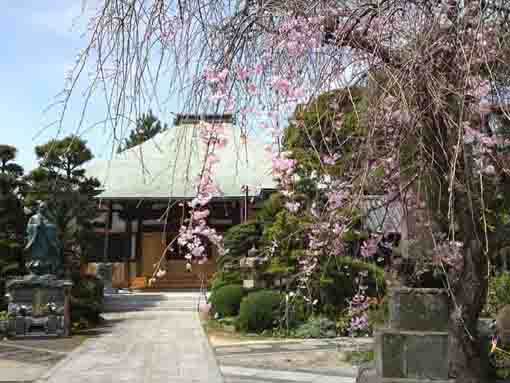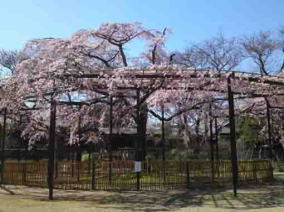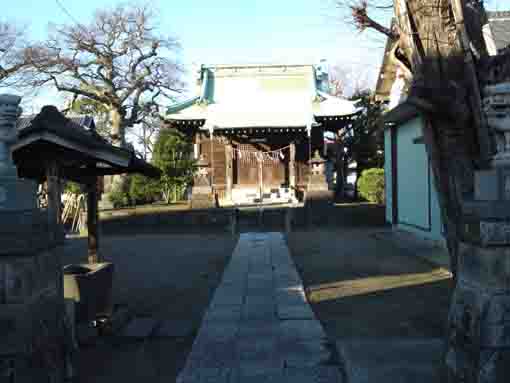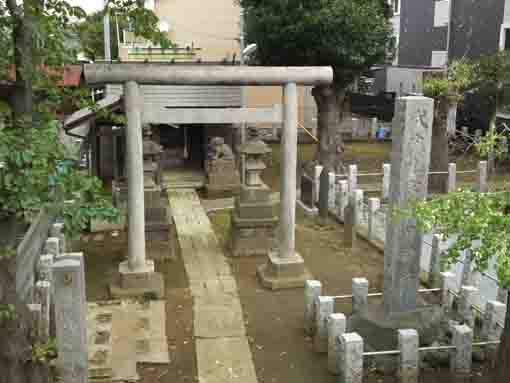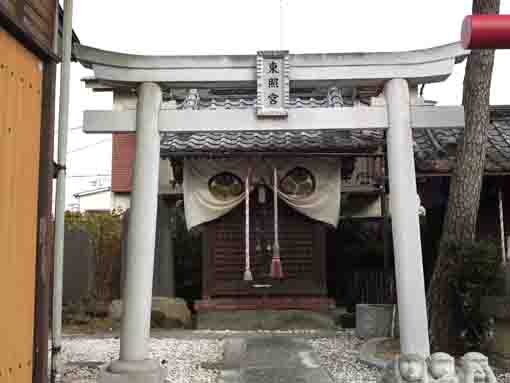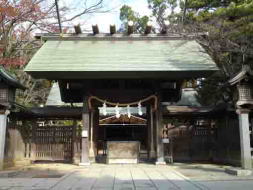Nakayama is in between Narita And Haneda International Airport
<クッキーについての同意並び欧州居住者向けプライバシーポリシー>
中山・下総・散歩道
Ryogokuji Temple in Gyotoku | The 11th Temple

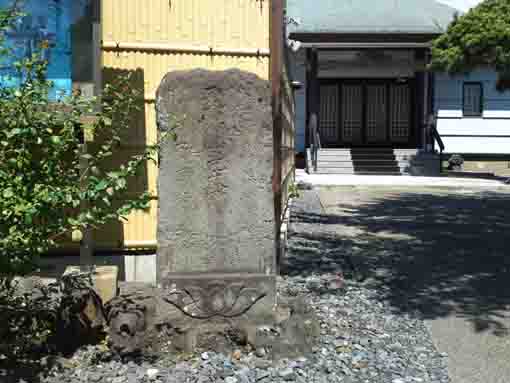
Going down the street to Edogawa River after getting off Tozai line at Baraki Nakayama Station, there are several old Japanese style residences that tells the area might be flourished with salt industry, and there is Kaichusan Ryogokuji Temple, the 11th temple of the 33 pilgrimage in Gyotoku and Urayasu in it.
In Edo Meisho Zue (a guide book describing Edo in Edo period), Ryogokuji Temple keeps 'Kagami no Miei' drawn by Enko Daishi himself and a toba bar with some letters written by the venerable Yuten, the 36th abbot of Shiba Zojoji Temple in Edo.
Why don't you visit Kaichusan Rogokuji Temple?
Kaichusan Ryogokuji Temple
The History of Kaichusan Rogokuji Temple
Kaichusan Ryogokuji Temple is the noted temple that Edo Meisho Zue, Katsushikaki and Katsushikashiryaku describe. Though Koya area where Ryogokuji Temple stands is in the north shore of Edogawa Drainage Canal, it was in Gyotoku in Edo period and it was prosperous with salt industry.Kaichusan Ryogokuji Temple was built by the chief priest Toei in 1691 as a branch temple of Joshoji Temple in Funabashi belonging to Jodo Sect. The Kaichusan implies the landscapes in Edo period that it faced to the sea since Kaichu means 'in the sea'.
According to Edo Misho Zue, Rogokuji Temple has a self-portrait called 'Kagami no Miei' drawn by Enko Daishi Honen and a toba bar with some letters written by the venerable Yuten, the 36th abbot of Shiba Zojoji, whom the 6th Shogun of Edo Bakufu, Yoshinobu Tokugawa, deeply believed. The principle image of it is the statue of Amidanyorai.
The self-portrait was given to Awanosuke by Enko Daishi. Awanosuke fallowed Enko Daishi to support him when he was exiled to Sanuki province (Kagawa prefecture). Awanosuke intended to study Buddhism after that, and he met Shinbei Isogai at Koya and stayed his house when went to the eastern Japan. Then they went around Japan together as their ascetic practices. During their journey, Awanosuke passed away and left the portrait. Then Shinbei brought it to Koya and he built a small shrine to dedicate it carefully as the principle image of it in the land where Ryogokuji Temple stands now.
Moreover, the venerable Yuten held the 550th anniversary of the venerable Honen at Ryogokuji Temple famous for the self-portrait of Honen, and he left his letters on the toba bar there. This toba bar is said to be very famous for having the divine favor to cure epidemics. Moreover, according to Katsushikashiryaku, the Shogun visited to see it.
Anyway, some said Ryogokuji Temple was built by the venerable Yuten in 1686.
Kaichusan Ryogokuji Temple is 11th temple of the 33 pilgrimage of Gyotoku and Urayasu.
抜粋・引用および参考文献
江戸名所図会6 ちくま学芸文庫
房総叢書 紀元二千六百年記念 第8卷葛飾紀
房総叢書 紀元二千六百年記念 第6卷葛飾誌略
浄土宗千葉教区ホームページ
「葛飾紀」の世界 文芸社
江戸川ライン歴史散歩 崙書房
ウィッキペディア
The Temples of the 33 Pilgrimage in Gyotoku & Urayasu
The list of the temples of the 33 Pilgrimages in Gyotoku and Urayasu
- 01 Tokuganji : 5-22 Hongyotoku Ichikawa-shi
- 02 Fukusenji :2-7 Futamata Ichikawa-shi
- 03 Choshoji : 8-5 Hongyotoku Ichikawa-shi
- 04 Jishoin : 1-10 Hongyotoku Ichikawa-shi
- 05 Daitokuji : 5-13 Shimonijuku Ichikawa-shi
- 06 Jorinji (abandoned) : around Kawara Ichikawa-shi
- 07 Shogenji : 3-6 Kawara Ichikawa-shi
- 08 Yofukuin : 5-16 Kawara Ichikawa-shi
- 09 Ryugonji (Sorinji) : 3-10-2 Tokagi Ichikawa-shi
- 10 Fukuoji (Sorinji) : 3-10-2 Tokagi Ichikawa-shi
- 11 Ryogokuji : 2-16-4 Koya Ichikawa-shi
- 12 Anyoji : 2-16-35 Koya Ichikawa-shi
- 13 Hosenji : 7-22 Hongyotoku Ichikawa-shi
- 14 Hozenji : 1-25 Honshio Ichikawa-shi
- 15 Jokanji : 23-24 Hongyotoku Ichikawa-shi
- 16 Shingyoji (Kyoshinji) : 38-18 Hongyotoku Ichikawa-shi
- 17 Kyozenji (Kyoshinji) : 38-18 Hongyotoku Ichikawa-shi
- 18 Hoshoji (abandoned) : now brought into 19 Tokuzoji
- 19 Tokuzoji : 8-10 Sekigashima Ichikawa-shi
- 20 Seiganji : 4-8 Oshikiri Ichikawa-shi
- 21 Korinji : 12-20 Oshikiri Ichikawa-shi
- 22 Hodenji : 7-1 Minato Ichikawa-shi
- 23 Enmyoin : 11-21 Minato Ichikawa-shi
- 24 Zenshoji : 18-20 Minato Ichikawa-shi
- 25 Genshinji : 1-16-26 Katori Ichikawa-shi
- 26 Ryozenji : 2-12-18 Ainokawa Ichikawa-shi
- 27 Shinseiji : 1-9-1 Arai Ichiakawa-shi
- 28 Enmeiji : 1-9-2 Arai Ichikawa-shi
- 29 Zenpukuji : 26-27 Todaijima Urayasu-shi
- 30 Kezoin : 3-10-3 Nekozane Urayasu-shi
- 31 Togakuji : 2-4-27 Horie Urayasu-shi
- 32 Hojoin : 4-14-1 Horie Urayasu-shi
- 33 Dairenji : 4-14-2 Horie Urayasu-shi
- extra Fujiwara Kannondo Hall 2-234 Fujiwara-cho Funabashi-shi
* Please ask some specific information in each temple.
Why don't you visit the 33 Temples on this movie?
This movie is a slideshow created by some pictures of the temples. Why don't you watch it?
The Location and Access to Ryogokuji Temple
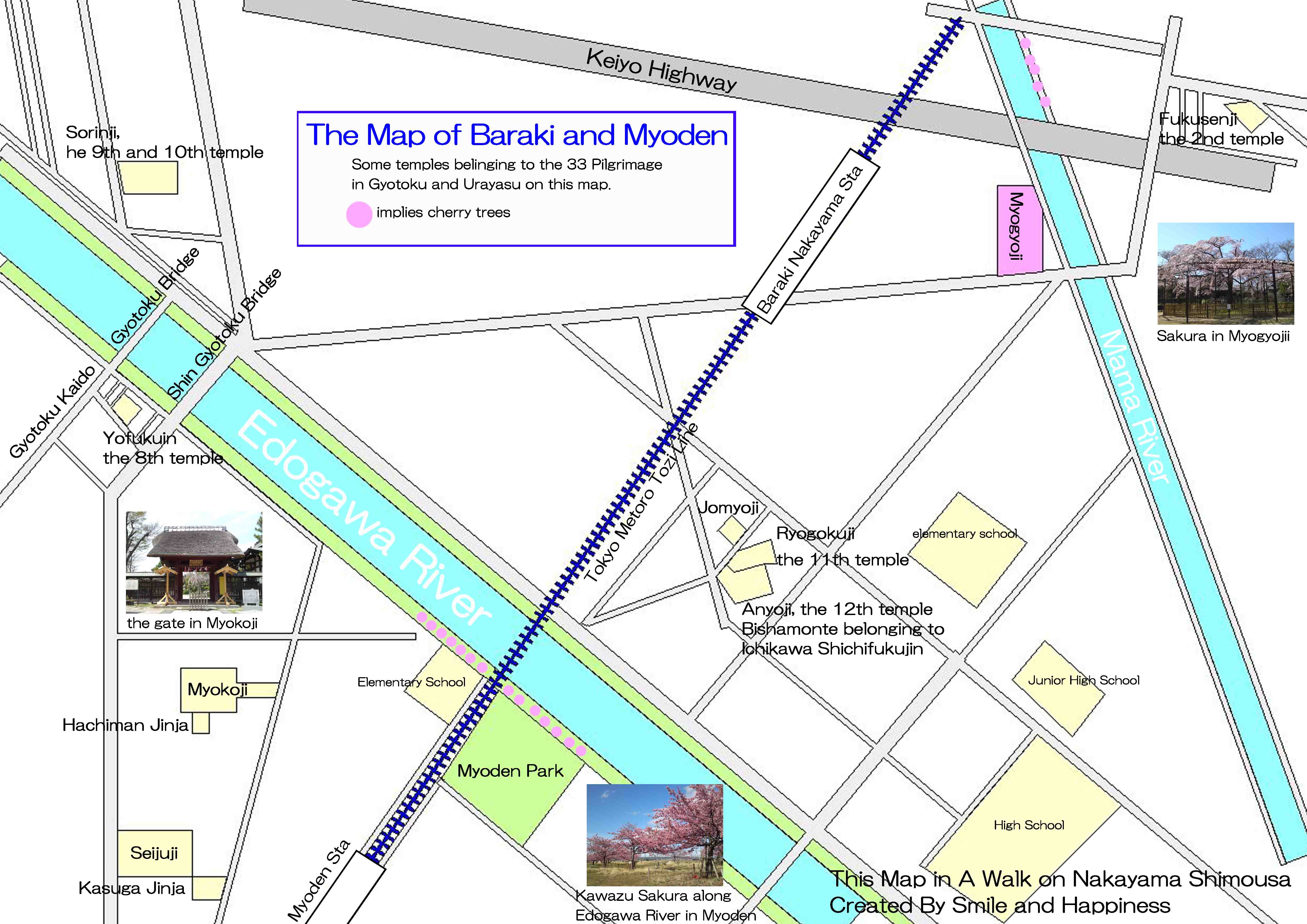
The map of the noted spots in Baraki and Myoden Areas
The Map of the landmarks in Baraki Nakayama and Myoden AreasKaichusan Ryogokuji Temple
- Ryogokuji-Temple has a great accessibility from both Narita and Haneda International Airport.
- From Narita International Airport, take JR Sobu-express line, transfer the line at Nishi-funabashi to Tozai line of Tokyo Metro bound to Nakano or Mitaka, get off Baraki-Nakayama Sta. And also take Keisei-line, transfer the line at Funabashi to Sobu-Local line, and transfer the line at Nishi-funabashi to Tozai line of Tokyo Metro bound to Nakano or Mitaka, get off Baraki-Nakayama Sta. It takes minimally 50 minutes from Narita Airport.
- From Haneda International Airport, take Keikyu-line bound to Narita, transfer the line at Nihonbashi to Tozai line of Tokyo Metro bound to Nishifunabashi, Tsudanuma or Katsutadai, get off Baraki-Nakayama Sta.
- From Tokyo (Otemachi) Sta, take Tozai line of Tokyo Metro bound to Nishi-funabashi, Tsudanuma or Katsutadai, get off Baraki-Nakayama Sta.
- From Akihabara Sta, take Sobu line bound to Chiba, Tsudanuma or Nishi Funabashi, transfer the line at Nihonbashi to Tozai line of Tokyo Metro, get off Baraki-Nakayama Sta.
- Take 10 minute walk from Barakii-Nakayama Sta.
- 2-16-4 Koya, Ichikawa-shi, Chiba-ken
The Noted Spots near Kaichusan Ryogokuji Temple

Ryogokuji Temple
- 広告 Advertisement -
